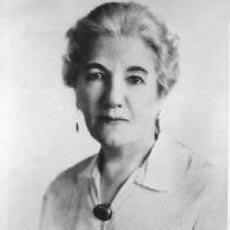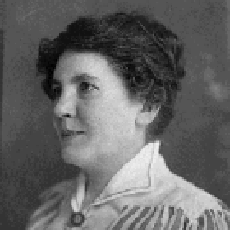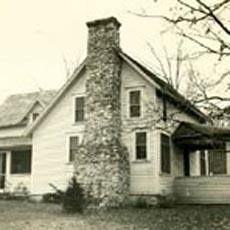
DOUG JOHNSON: I'm Doug Johnson.
SHIRLEY GRIFFITH: And I'm Shirley Griffith with PEOPLE IN AMERICA in VOA Special English. Today, we tell about Laura Ingalls Wilder who wrote the "Little House" books for children.
(MUSIC)
MOTHER: "Daisy, it's time!"
DAISY: "Mom!"
MOTHER: "Now, Daisy, that's enough music for tonight. You have to go to sleep."
DAISY: "But, Mom, it's still early!"
MOTHER: "Young lady, you have school tomorrow. You need your rest."
DAISY: "But I'm not sleepy! Besides, you promised to read me a story."
MOTHER: "OK. But just for a little while."
DAISY: "Yeah! Please make it 'The Little House on the Prairie.' I love that book. Please, please, please!"
MOTHER: "Alright, here goes."

"A long time ago, when all the grandfathers and grandmothers of today were little boys and girls or very small babies, or perhaps not even born, Pa and Ma and Mary and Laura and Baby Carrie left their little house in the Big Woods of Wisconsin. They drove away and left it lonely and empty in the clearing among the big trees, and they never saw that little house again."
DOUG JOHNSON: Since the 1930s, children have gone to sleep listening to the words of Laura Ingalls Wilder. She wrote nine "Little House" books that take place in the mid 1800s. They tell about a family who lived on the great flat land known as the prairie in the central part of the United States. They were known as pioneers.
The family moved from one small house to another. They carried all they owned in a wagon, pulled by a horse. They did not like to live and work in big cities. They enjoyed farming and raising animals. And they loved the open spaces of the prairie.
SHIRLEY GRIFFITH: Laura Ingalls was born in 1867 in an area known as the "Big Woods" of Wisconsin. Her father was said to have a "restless spirit." He did not like to live in one place very long. The family moved from Wisconsin to Kansas, then to Minnesota, Iowa, and South Dakota.
Laura's father was always looking for a better job, or better land to settle on. Life for the Ingalls family was not easy. They were often cold and hungry. Laura remembered these times when she wrote her "Little House" books later in life.
DOUG JOHNSON: When she was about 16, Laura began teaching school. Two years later, she married Almanzo Wilder. A year and a half after that, Laura gave birth to a baby girl. They named her Rose. They hoped to settle on a nice farm and raise a large family. But they experienced a series of bad luck.
For several years there was no rain. Their crops failed. Then Almanzo became very sick. Their home and barn were destroyed by fire. They had almost no money. For many years they moved from place to place and worked at many different jobs. Finally, Rose urged her mother to try writing for a living. And that is when the idea for the "Little House" books was born.
SHIRLEY GRIFFITH: Laura Ingalls Wilder's first book is called "Little House in the Big Woods." It was published in 1932. It tells of her life when she was about five years old. She calls her mother and father "Ma" and "Pa". She also includes an older sister named Mary and a younger sister named Carrie in her stories. This first book tells how Laura helps her family on their small farm.
She learns how to grow crops and prepare for a cold winter. After working hard all day, Pa would play his fiddle, and sometimes they would sing and dance. Life was simple, but good.

DOUG JOHNSON: The next book in the series is called "Farmer Boy." It tells the story of Almanzo Wilder growing up on a farm in New York State. It is different from the other "Little House" books because it is only about Almanzo.
Then, in 1935, Laura Ingalls Wilder wrote her most famous book, "Little House on the Prairie." It tells stories that are exciting, and sometimes scary, like this one.
JIM TEDDER: "One dark night after the family had gone to bed, Laura thought she heard a strange sound outside. Suddenly, Jack, her dog, began to bark. He was afraid. And so was their horse, Patty. What could it be? Was someone trying to break in and rob them? They could not call for help. Their closest neighbors were far away. And then they heard a horrible sound."
SHIRLEY GRIFFITH: Wolves were not the only problems the Ingalls family faced. In the next book, "On the Banks of Plum Creek," something unusual happens.
JIM TEDDER: "Laura's father had planted a large crop of wheat. The weather had been good. The wheat was tall, and ready to be cut and sold. The money from the crop would make them feel rich. One day, Laura was in their little house when she saw something strange. It looked like the sky was getting dark. Her mother said a storm was coming. They walked out the door a short distance to see the storm. But there was no wind, and no thunder or lightning. They saw a huge cloud go across the sun. The cloud was dark, but seemed to have little golden lights inside. What could it be? Then...they heard it."
"One, two, then ten ... 100 ... then thousands of grasshoppers began falling from the sky. Laura screamed as the insects landed on her clothes and crawled in her hair. The family quickly ran into the house. But the grasshoppers kept coming. They soon covered the roof of the house and the ground outside. Pa remembered the wheat crop and looked out the window. The grasshoppers were attacking the crops in the fields. He could even hear them as they chewed and chewed. Within a short time, there was nothing left. There would be no wheat crop this year. And there would be no money."
DOUG JOHNSON: The next "Little House" book is called "By the Shores of Silver Lake." In this book, the Ingalls family moves to South Dakota. Pa takes a job in a small store owned by the railroad. Once again he builds a house for his family, and they hope that their traveling days are over.
"The Long Winter" is the next book in the series by Laura Ingalls Wilder. It tells about an old Native American man who warns that there will be seven months of heavy snow and wind.
The first blizzard comes in the middle of October, much sooner than usual. One storm follows another. For weeks, the Ingalls have only potatoes and bread to eat. They run out of wood to burn for heat. The blizzards are so bad that the children cannot even walk to school.

SHIRLEY GRIFFITH: The next book in the series, "Little Town on the Prairie" was published in 1941. In this book, the Ingalls family continues to move from place to place in the central prairie land of America. Laura grows older and becomes a school teacher. In the next book, "These Happy Golden Years," Laura and Almanzo are married and move into their own home. The last book in the series is called "The First Four Years." It tells about Laura and Almanzo as they begin their life together.
DOUG JOHNSON: The "Little House" books are all fiction. But they are closely based upon the memories of Laura Ingalls Wilder. When she was asked which parts of her stories were true, she often said: "I lived everything I wrote."
The writer and her husband finally settled at Rocky Ridge Farm in Mansfield, Missouri. Almanzo was 92 when he died in 1949. Laura died in 1957, just after her 90th birthday.
SHIRLEY GRIFFITH: The Wilder's Rocky Ridge Farm is now a museum. Thousands of people from around the world come to visit each year. The can see many of Laura's hand written pages for the "Little House" books. They can also see photographs of the family, and some of the clothes that Laura sewed while living on the prairie. Visitors can see tools and other things that Almanzo used to build their houses and farm the land. And they can see Pa's fiddle.
DOUG JOHNSON: The "Little House" books continue to sell very well. They have been translated into 45 languages. The books are written in a simple style that is easy for young people to understand. Many teachers in the United States and foreign countries use the books in their classrooms. They help students learn to read English, and to understand the history of pioneering life in America. And children around the world, just like Daisy, beg their parents for just one more story at bedtime.
MOTHER: "They were all happy that night. The fire was pleasant. Outside the sky was full of stars. Pa sat for a long time in the doorway and played his fiddle. He sang to Ma and Mary and Laura and to the starry night outside."
MOTHER: "Daisy? Daisy?"
DAISY: "Night Mom."
(MUSIC)
SHIRLEY GRIFFITH: This program was written by Jim Tedder and produced by Dana Demange. The mother and daughter were Caty Weaver and Daisy Bracken. I'm Shirley Griffith.
DOUG JOHNSON: And I'm Doug Johnson. Our programs are online with transcripts and MP3 files at voaspecialenglish.com. And you can find us on Facebook and YouTube at VOA Learning English. Join us again next week for PEOPLE IN AMERICA in VOA Special English.
grasshopper: an insect with long back legs, that can jump very high and that makes a sound with its legs 蝗虫;蚱蜢;蚂蚱
Alan Shepard, 1923-1998: the first American to fly in space
Ann Landers, 1918-2002: she helped millions of people deal with their problems
John Kenneth Galbraith, 1908-2006: He influenced economic thought for many years
Robert Frost, 1874-1963: most Americans can quote his poems
(来源:VOA 编辑:崔旭燕)
